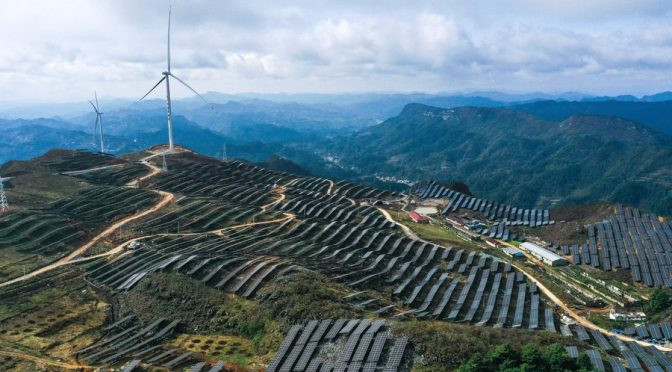Country on track reach 1,200GW of installed wind power and photovoltaic capacity by end of 2024 – six years ahead of Beijing’s target.
Between March 2023 and March 2024, China installed more solar than it had in the previous three years combined, and more than the rest of the world combined for 2023, the GEM analysts found. China is on track to reach 1,200GW of installed wind and solar capacity by the end of 2024, six years ahead of the government’s target.
“The unabated wave of construction guarantees that China will continue leading in wind and solar installation in the near future, far ahead of the rest of the world,” the report said.
However, analysts have cautioned that still more renewable capacity will be needed if China is to meet its target of reducing the carbon intensity of the economy by 18%, which is an important factor in reducing emissions. Carbon intensity refers to how many grams of CO2 are released to produce a kilowatt hour of electricity.
Earlier analysis suggests that China will need to install between 1,600GW and 1,800GW of wind and solar energy by 2030 to meet its target of producing 25% of all energy from non-fossil sources.
Between 2020 and 2023, only 30% of the growth in energy consumption was met by renewable sources, compared with the target of 50%.
“It is obviously important for China to keep on adding more renewable energy to meet its targets,” said Li Shuo, the director of the China Climate Hub at the Asia Policy Institute in Washington DC. “But it’s not as simple as you just keep building and it will be solved … [because] there is no sign that the country is trying to steer away from its coal consumption.”
Previous analysis by GEM and the Centre for Research on Energy and Clean Air, a thinktank, found that approvals of new coal power plants increased fourfold in 2022-2023, compared with the previous five-year period of 2016-2020, despite a pledge in 2021 to “strictly control” new coal power. Growth in total coal consumption increased from an average of 0.5% a year to 3.8% a year between the two time periods.
Geopolitical tensions such as the war in Ukraine, which focused many countries’ attention on energy supplies, and major power cuts in parts of China in recent years, have increased Chinese officials’ concerns about energy security.
China’s power grid remains reliant on coal, which officials see as necessary to mitigate the intermittency of renewable energy. And officials often see the coal industry as being a safe way to boost local GDP figures, although clean energy sectors are now the biggest driver of China’s economic growth, accounting for 40% of GDP expansion in 2023.
Analysts say that better storage and grid flexibility is necessary to efficiently use the increasing volume of clean energy being generated on China’s wind and solar farms.
The Chinese government is aware of this challenge, naming lithium-ion batteries as one of the “new three” technologies important for creating high-quality growth, along with electric vehicles and solar panels. Last year, $11bn was invested in grid-connected batteries, an increase of 364% on 2022.
The GEM report also highlighted China’s lead in actually building planned renewable energy infrastructure. The 339GW of wind and solar that has reached the construction stage represents one-third of proposed projects, far surpassing the global construction rate of 7%.
“China’s renewable energy pipeline is two times larger than the rest of the world,” Li said. “But the question we should increasingly ask ourselves is, how come the rest of the world is so slow?”
Amy Hawkins Senior China correspondent

